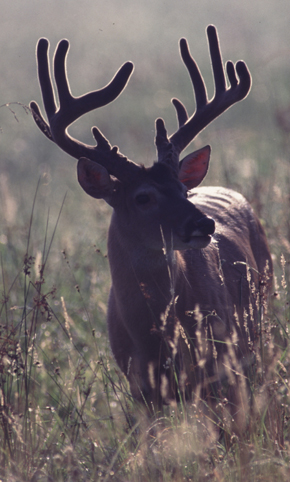Attracting Deer With Food Plots
Getting to the Nuts and Bolts

Figure on spending anywhere from $30 to $100 per acre to establish clover and alfalfa plots (clover is easier to establish and maintain but doesn’t last as many years as alfalfa). This includes seed, lime and fertilizer, but doesn’t include equipment or labor. If you don’t have the equipment you are money ahead to hire your neighbor to put your food plots in for you at a rate of about $15 to $30 per acre depending on the amount of seed bed preparation required. While commercially available food plot seed takes the guesswork out of the planting decision, you sure don’t need it to establish deer food. The local feed and seed store will offer many types of seed at a cost savings to you.
Expect to pay about $50 - $60 per acre for corn and sorghum, most of which will go into fertilizer (nitrogen is very expensive and it takes quite a bit for decent crops – at least 60 units per acre). I’m figuring you can get the seed for free. If not, at another $25 per acre. Chemicals are also expensive, and I figured the bare minimum into the price tag. Sorghum tends to be more competitive with weed pressure than corn, but still needs some help.
It’s worth the extra money to get RoundUp Ready soybeans. All tolled, a bean plot will cost you about $60 per acre.
Eventually, you may decide to buy your own equipment so you can better control the quality and timing of your seeding and plot maintenance. The range of prices is incredible. You can spend anywhere from a few thousand dollars to more than one hundred thousand dollars on equipment. One of my neighbors got by with bargain basement auction items and assembled a workable food plot system for less than $2,000. In contrast, another hunter who lives near me is pretty well off and enjoys equipment (a natural tendency for men). Tony bought a brand new $65,000 four-wheel drive 95 hp John Deere tractor just to plant 15 – 20 acres of food plots each spring!
Technical soil decisions (how much fertilizer and lime to add) are best left to the experts. These should be applied before planting (or shortly thereafter) to make sure they get incorporated fully. Don’t skimp on either component. Fertilizer increases protein content and yield considerably while the correct soil pH for your planting determines how robustly the crop will grow – and even if it will grow at all. A soil test is the best way to determine your situation and will return a recommendation of the required amount of both lime and fertilizer for the type of crop you are planting. Your local co-op elevator or county agricultural extension office can tell you how to take the sample and where to send it to have it analyzed.
If you’re not attracting and holding deer on your hunting area, you can bet someone else is nearby. Your loss is their gain. Doing anything will help. By planting only one or two small food plots you can greatly improve the quality of the hunting on your property while giving the deer all they need to achieve their genetic potential. Food plots are a win-win situation for serious deer hunters.
What You Need
For clover plots:
Seed: ladino clover has highest protein content, a mix of ladino, red and alsike is a classic clover blend
Minimum equipment: (no-till frost-seeding, small plots)
- Four-wheeler rear-mount sprayer
- Four-wheeler pull-behind mower
- Four-wheeler seed and fertilizer spreader
- Chemical: RoundUp for initial weed kill (usually done the fall before winter frost seeding)
- Bag fertilizer (get premixed for legumes from co-op)
Typical equipment: (complete till, larger plots)
- 50 to 60 hp tractor
- 14 foot disc
- Small drill
- 3-point brush cutter/mower
- Local co-op to apply fertilizer
For corn, sorghum or beans:
Seed: Often you can get corn and sorghum free from conservation groups, choose RoundUp Ready soybeans to assure weed control
Typical equipment: (for all sized plots)
- 50 to 60 hp tractor
- 4-row corn planter with bean and sorghum seed plates
- 14 foot disc
- 250 gallon sprayer
- Chemicals: consult with local co-op for corn and sorghum, you may choose to have co-op apply all chemicals, RoundUp for RoundUp Ready soybeans.
- Co-op to apply all fertilizer
Maintaining a Clover or Alfalfa Plot
Beyond necessary planting steps that must include proper lime application, here are three things you’ll need to do in order to keep your clover and alfalfa plots flourishing.
1.Mow as required with the deck on a high setting to suppress weeds without smothering crop with residue. Better yet, have the plot baled by a neighbor on halves to control weeds and produce income.
2.Fertilize once per year (usually in early spring) for optimum benefit and yield.
3.Alfalfa is very susceptible to leafhoppers and damage from other insects. Check often and spray if the problem occurs. Look for widespread occurrence of brown and/or eaten leaves.
Discussion